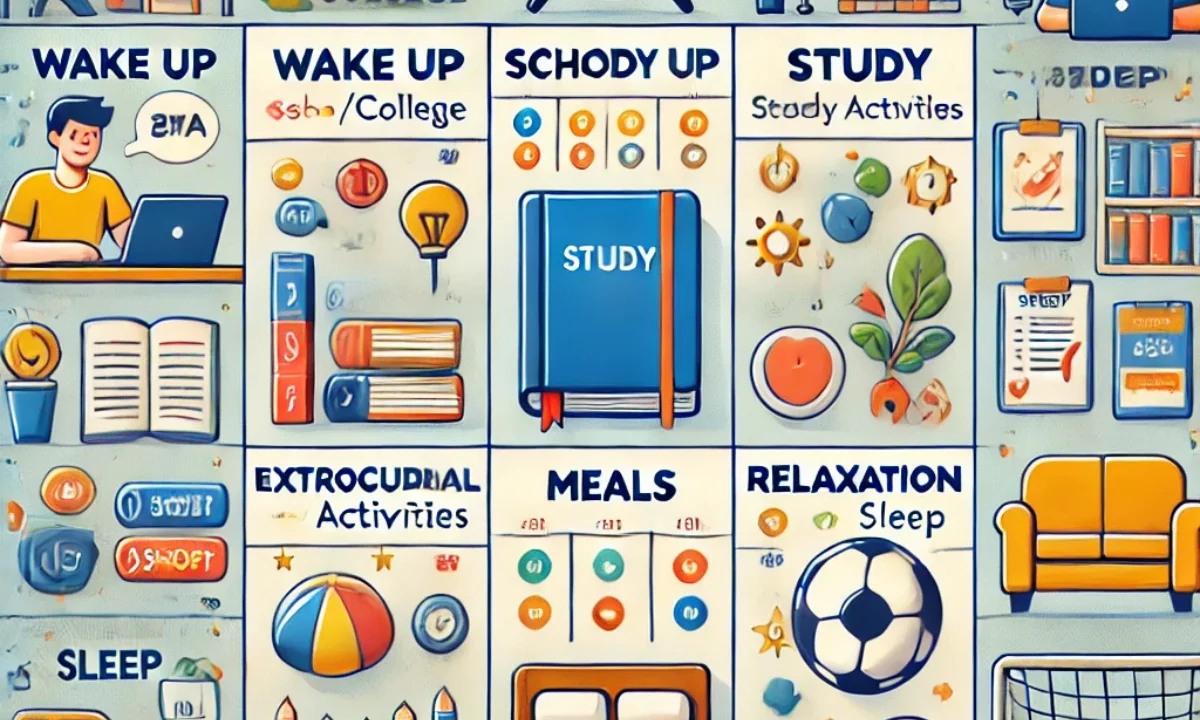Introduction
How to Make a Time Table for Daily Routine for Students – Time management is a crucial skill for students. A well-structured timetable helps students balance their academic responsibilities, extracurricular activities, and personal life efficiently. This guide will provide a step-by-step process to create a practical and effective daily routine that enhances productivity and reduces stress.
Importance of a Time Table for Students
1. Enhances Productivity
A structured timetable allows students to allocate time efficiently for studies, relaxation, and extracurricular activities, leading to improved productivity.
2. Reduces Stress
By following a fixed routine, students can avoid last-minute rushes and deadline pressure, reducing overall stress levels.
3. Improves Time Management Skills
A timetable helps in prioritizing tasks, ensuring that students make the best use of their time.
4. Encourages Discipline
Following a daily schedule inculcates discipline and responsibility in students, making them more organized in their approach.
Read More – How to Look Slim in Saree
Steps to Create a Time Table for Daily Routine
Step 1: Identify Your Daily Tasks
Make a list of daily activities, including:
- School/College hours
- Homework and study sessions
- Meals and breaks
- Extracurricular activities
- Leisure and relaxation time
- Sleep schedule
Step 2: Set Priorities
Prioritize tasks based on their importance and deadlines. Academics should be given top priority, followed by other essential activities.
Step 3: Allocate Time Blocks
Divide your day into time blocks:
- Morning study session (if applicable)
- School/College hours
- Afternoon study session
- Homework and revision time
- Playtime or extracurricular activities
- Family and leisure time
- Sleep schedule
Step 4: Keep Time for Breaks
Short breaks between study sessions improve focus and retention. Use the Pomodoro technique (25 minutes study + 5 minutes break) to stay productive.
Step 5: Avoid Overloading
Overburdening yourself with excessive tasks can lead to burnout. Ensure that your schedule is realistic and manageable.
Step 6: Be Flexible
A timetable should be adaptable. Adjust your schedule if unexpected tasks arise, but ensure that your core routine remains unchanged.
Sample Daily Time Table for Students
School-going Students
| Time Slot | Activity |
|---|---|
| 6:00 AM – 7:00 AM | Wake up & morning routine |
| 7:00 AM – 8:00 AM | Breakfast & preparation |
| 8:00 AM – 2:00 PM | School hours |
| 2:00 PM – 3:00 PM | Lunch & rest |
| 3:00 PM – 5:00 PM | Homework & revision |
| 5:00 PM – 6:00 PM | Outdoor activities |
| 6:00 PM – 7:00 PM | Leisure & relaxation |
| 7:00 PM – 8:00 PM | Dinner & family time |
| 8:00 PM – 9:30 PM | Night study session |
| 9:30 PM – 10:00 PM | Relaxation & bedtime |
College Students
| Time Slot | Activity |
| 6:00 AM – 7:00 AM | Wake up & exercise |
| 7:00 AM – 8:00 AM | Breakfast & preparation |
| 8:00 AM – 2:00 PM | College hours |
| 2:00 PM – 3:00 PM | Lunch & rest |
| 3:00 PM – 5:00 PM | Self-study & assignments |
| 5:00 PM – 6:00 PM | Extracurricular activities |
| 6:00 PM – 7:00 PM | Relaxation & hobbies |
| 7:00 PM – 8:00 PM | Dinner & family time |
| 8:00 PM – 10:00 PM | Night study session |
| 10:00 PM – 10:30 PM | Wind down & sleep |
Tips for Maintaining Your Time Table
1. Stick to Your Schedule
Consistency is key. Try to follow your timetable diligently for maximum benefits.
2. Keep Some Buffer Time
Allow extra time between tasks to accommodate unforeseen situations.
3. Use Productivity Tools
Utilize planners, mobile apps, or alarms to remind yourself of tasks.
4. Evaluate and Adjust
Review your timetable weekly and make necessary changes to improve efficiency.
5. Get Enough Sleep
Lack of sleep affects concentration and productivity. Ensure 7-9 hours of sleep daily.
Conclusion
Creating a timetable for students is an essential step toward effective time management and academic success. By following a structured routine, students can balance studies, extracurricular activities, and relaxation efficiently. With discipline and consistency, a well-planned schedule can lead to improved performance, reduced stress, and overall well-being. Start creating your personalized timetable today and take control of your daily routine!

1 thought on “How to Make a Time Table for Daily Routine for Students”